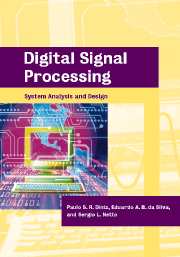Book contents
- Frontmatter
- Contents
- Preface
- Introduction
- 1 Discrete-time systems
- 2 The z and Fourier transforms
- 3 Discrete transforms
- 4 Digital filters
- 5 FIR filter approximations
- 6 IIR filter approximations
- 7 Finite-precision effects
- 8 Multirate systems
- 9 Filter banks and wavelets
- 10 Efficient FIR structures
- 11 Efficient IIR structures
- 12 Implementation of DSP systems
- References
- Index
7 - Finite-precision effects
Published online by Cambridge University Press: 05 June 2012
- Frontmatter
- Contents
- Preface
- Introduction
- 1 Discrete-time systems
- 2 The z and Fourier transforms
- 3 Discrete transforms
- 4 Digital filters
- 5 FIR filter approximations
- 6 IIR filter approximations
- 7 Finite-precision effects
- 8 Multirate systems
- 9 Filter banks and wavelets
- 10 Efficient FIR structures
- 11 Efficient IIR structures
- 12 Implementation of DSP systems
- References
- Index
Summary
Introduction
In practice, a digital signal processing system is implemented by software on a digital computer, either using a general-purpose digital signal processor, or using dedicated hardware for the given application. In either case, quantization errors are inherent due to the finite-precision arithmetic. These errors are of the following types:
Errors due to the quantization of the input signals into a set of discrete levels, such as the ones introduced by the analog-to-digital converter.
Errors in the frequency response of filters, or in transform coefficients, due to the finite-wordlength representation of multiplier constants.
Errors made when internal data, like outputs of multipliers, are quantized before or after subsequent additions.
All these error forms depend on the type of arithmetic utilized in the implementation. If a digital signal processing routine is implemented on a general-purpose computer, since floating-point arithmetic is in general available, this type of arithmetic becomes the most natural choice. On the other hand, if the building block is implemented on special-purpose hardware, or a fixed-point digital signal processor, fixed-point arithmetic may be the best choice, because it is less costly in terms of hardware and simpler to design. A fixed-point implementation usually implies a lot of savings in terms of chip area as well.
For a given application, the quantization effects are key factors to be considered when assessing the performance of a digital signal processing algorithm.
- Type
- Chapter
- Information
- Digital Signal ProcessingSystem Analysis and Design, pp. 310 - 353Publisher: Cambridge University PressPrint publication year: 2002

